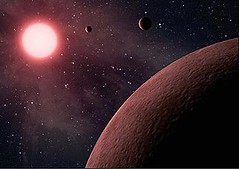 美國太空總署(NASA) 1月26日發佈消息,說明克卜勒太空望遠鏡新發現11個系外行星系統,其中確認有26顆行星。現在,人們所知的銀河行星數量,增加為2倍以上,有一顆以上行星環繞的「多行星恆星」,則增加為3倍以上。
美國太空總署(NASA) 1月26日發佈消息,說明克卜勒太空望遠鏡新發現11個系外行星系統,其中確認有26顆行星。現在,人們所知的銀河行星數量,增加為2倍以上,有一顆以上行星環繞的「多行星恆星」,則增加為3倍以上。
這些系外行星,以非常靠近的距離,繞行所屬的母星;大小都比地球大1.5倍以上、有的還大過太陽系裡最大的星球──木星。
在華盛頓NASA總部參與克卜勒計畫的科學家哈金斯(Doug Hudgins)表示,「執行克卜勒任務之前,我們知道整片天空大概有500顆系外行星。」
現在NASA證實有超過700顆系外行星,不過只有少數是類地行星。
新發現的15顆行星,體積大小介於地球和海王星之間,而質量是地球的17倍。
系外行星每6到143天繞行母星1次;系外行星和母星的距離,比金星和太陽的距離來比,還要近。
如果行星運行接近母星和地球(即凌日),從地球可視的母星光度就會開始輕微下降,克卜勒太空望遠鏡藉這時候,反覆測量15萬顆母星光度的變化,就可以得知行星在什麼時侯通過母星。
新發現的每一個行星系統都有2到5顆不等的行星,對母星繞行,而且和母星的距離都很近。
因為行星系統內的空間擁擠,行星之間的引力作用,就會影響到一連串的行星、加速或減速繞行母星;加速繞行的結果,會改變每一顆行星繞行母星的時間。
 克卜勒太空望遠鏡觀察光度變化的方法、叫作凌日時間變分法(Transit Timing Variations, TTVs,和凌日法有關),來發現這種星體間、微妙的交互作用所造成的太空現象。
克卜勒太空望遠鏡觀察光度變化的方法、叫作凌日時間變分法(Transit Timing Variations, TTVs,和凌日法有關),來發現這種星體間、微妙的交互作用所造成的太空現象。
利用TTVs來證實行星系統是否存在,不須要再大費周章做地面觀察,確實可以加快速度、確認行星候選名單中的行星;而且有了這種方法,有些母星可能暗淡不明,克卜勒望遠鏡也能做確認,發現行星。
Kepler-25, Kepler-27, Kepler-30, Kepler-31 and Kepler-33這5個行星系統裡面,都有一對行星;在內側的那顆行星繞行母星2週,外側那顆行星剛好繞母星一週。
Kepler-23, Kepler-24, Kepler-28 and Kepler-32這4個行星系統裡面也有一對行星;在外側的行星繞母星2週的時間,內側的行星則繞了母星3次。
 博士後研究員、也是確認4個行星系統的論文主要作者斯蒂芬(Jason Steffen)談道,「以上這些繞行的模式,讓我們對引力和行星間的交互作用,了解更深;就好像我的兒子盪鞦韆,越來越能抓準踢腿時機,能盪得更高。」
博士後研究員、也是確認4個行星系統的論文主要作者斯蒂芬(Jason Steffen)談道,「以上這些繞行的模式,讓我們對引力和行星間的交互作用,了解更深;就好像我的兒子盪鞦韆,越來越能抓準踢腿時機,能盪得更高。」
kepler-33行星系統的母星年齡來得比太陽老、體積也比太陽大多了,而且藏著最多還未發見的行星;目前系統內有5顆行星,比地球大1.5倍到5倍之多。
科學家說:「行星經過母星時所造成的光度變化、繞行母星所花費的時間、和母星本身的屬性:這些都是識別特徵,來確認行星是否存在的。」
天文學家如果發現,有一顆行星,好像俱備上述所說的識別特徵,來繞著母星的話,有非常高的機率就是這個行星系統裡,新發見的行星。
想要知道是不是發見了一顆行星,必須檢驗是不是至少有3次相似的繞行特徵,最後再配合地面望遠鏡,來確認是否發現新行星。
以上根據這些新的研究發現、所撰述的4篇論文,分別刊載在《天文物理期刊》(Astrophysical Journal)和《皇家天文學會月報》(Monthly Notices of the Royal Astronomical Society)。
The Kepler spacecraft has discovered 11 new planetary systems hosting 26 confirmed planets, the National Aeronautics and Space Administration, NASA, announced Thursday. These discoveries nearly double the number of verified planets and triple the number of stars known to have more than one planet that passes in front of its star.
These exoplanets, outside the Earth's solar system, orbit close to their host stars and range in size from 1.5 times the radius of Earth to larger than Jupiter, the largest planet in Earth's solar system.
"Prior to the Kepler mission, we knew of perhaps 500 exoplanets across the whole sky," said Doug Hudgins, Kepler program scientist at NASA Headquarters in Washington.
Of the more than 700 exoplanets now confirmed, only a handful are known to be rocky, like the Earth.
In size, 15 of the newly discovered planets are between Earth and Neptune, which is 17 times the mass of Earth.
The exoplanets orbit their host stars once every six to 143 days. All are closer to their host stars than Venus is to our Sun.
Kepler identifies planet candidates by repeatedly measuring the change in brightness of more than 150,000 stars to detect when a planet passes in front of the star. That passage casts a small shadow toward Earth and the Kepler spacecraft.
Each of the new confirmed planetary systems contains two to five closely spaced transiting planets.
In tightly packed planetary systems, the gravitational pull of the planets on each other causes some planets to accelerate and some to decelerate along their orbits. The acceleration causes the orbital period of each planet to change.
Kepler detects this effect by measuring the changes, or so-called Transit Timing Variations, TTVs.
Planetary systems with TTVs can be verified without requiring extensive ground-based observations, accelerating confirmation of planet candidates. The technique also increases Kepler's ability to confirm planetary systems around faint, distant stars.
Five of the systems (Kepler-25, Kepler-27, Kepler-30, Kepler-31 and Kepler-33) contain a pair of planets where the inner planet orbits the star twice during each orbit of the outer planet.
Four of the systems (Kepler-23, Kepler-24, Kepler-28 and Kepler-32) contain a pairing where the outer planet circles the star twice for every three times the inner planet orbits its star.
"These configurations help to amplify the gravitational interactions between the planets, similar to how my sons kick their legs on a swing at the right time to go higher," said Jason Steffen, the postdoctoral fellow, and lead author of a paper confirming four of the systems.
Kepler-33, a star that is older and more massive than our Sun, had the most planets yet discovered. The system hosts five planets, ranging in size from 1.5 to five times that of Earth.
The decrease in the star's brightness and duration of a planet's transit in front of its star, combined with the properties of its host star, present a recognizable signature, the scientists say.
When astronomers detect planet candidates that exhibit similar signatures around the same star, the likelihood of any of these planet candidates being a false positive is very low.
At least three transits are required to verify a signal as a planet. Follow-up observations from ground-based telescopes confirm the discoveries.
These findings are published in four separate papers in the "Astrophysical Journal" and the "Monthly Notices of the Royal Astronomical Society."





